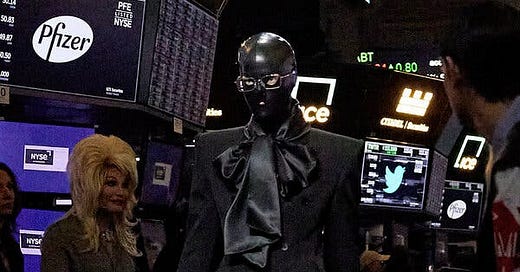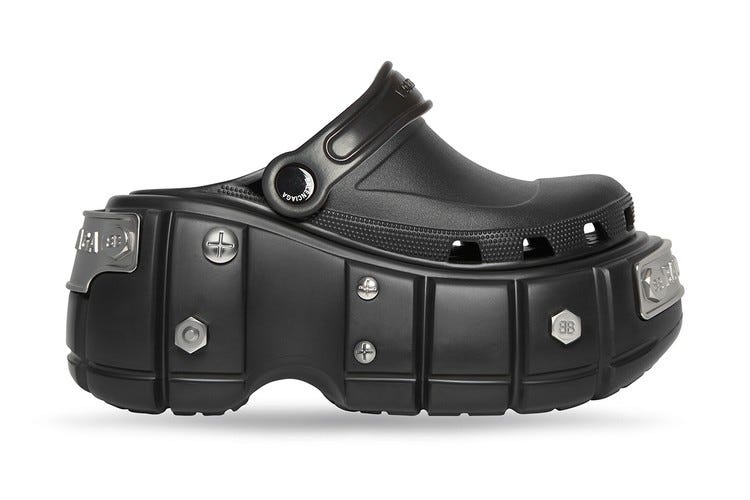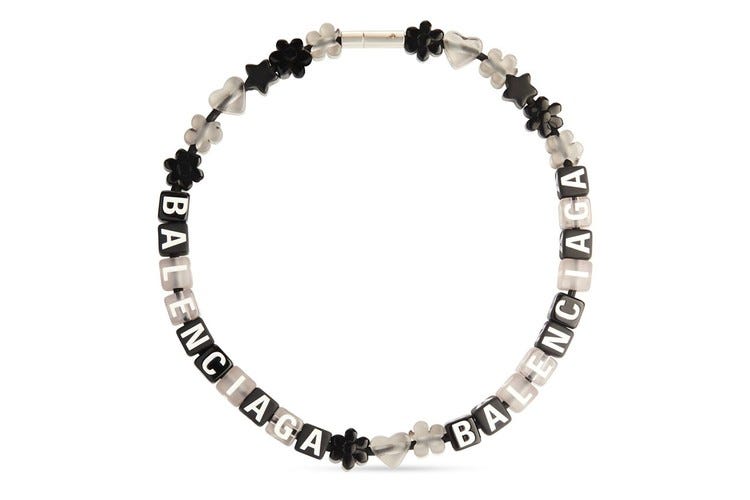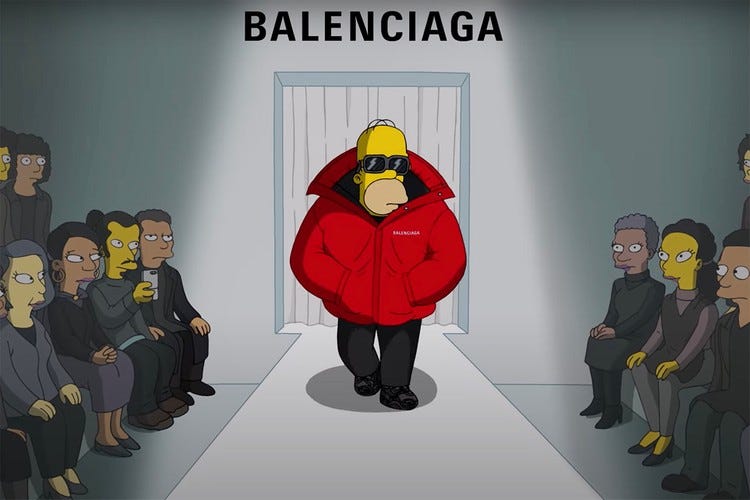Last week, Balenciaga showcased its Spring 2023 collection at the New York Stock Exchange. The venue choice – unexpected but very Balenciaga – sent fashion press into a frenzy, who made reaching connections between fashion, late-capitalism, and the recent S&P 500 sell-off.
Well, here’s another take you can put on the pile: the latest show marks Balenciaga’s stature as a commercial mega-force in luxury fashion.
Since Demna Gvasalia became its creative director in 2015, Balenciaga has grown in footprint, value, and revenue, and now sits comfortably alongside the other luxury power brands. It’s the third largest in Kering’s stable, after Saint Laurent and Gucci, and is thought to achieve around €2bn in revenue, having broken the €1bn mark a couple of years ago.
The brand’s endured success is fascinating, given its outlandish presentations, hard-to-get designs, and its acute focus on the present – all of which might make you think the brand would end up being a flash in the pan. And yet Balenciaga is still here and only growing larger.
So, no better time for an unpack of Balenciaga to work out what’s behind its success.
I think there are four key aspects:
1. It helps steer luxury’s new course
Over the last decade, luxury has moved away from its traditional, aristocratic image towards a more contemporary and inclusive one, driven by the new generation of luxury consumers and their democratic values. For the past few years, Balenciaga has operated at the forefront of this evolution, both aligning with and catalysing it forwards.
Karen Van Godtsenhoven, an associate curator at the Metropolitan Museum of Art’s Costume Institute, comments in Vogue how Demna Gvasalia’s designs for Balenciaga are “different from most luxury brands, which aim to be more exclusive—something that not everyone can have. He makes outfits for a raver, a businesswoman, a security guard, and it’s a more democratic approach, saying that these are all equal types.”
While £500-1000 sneakers are, of course, not democratically priced, the points of inspiration behind these products, and how – and on who – they are being presented are more democratised. “He took the items of everyday life — waders, Crocs, Ikea bags — and treated them like fetish objects,” writes The New York Times’ fashion editor Vanessa Friedman. “He made the sneaker as important as the handbag. He embraced all ages and genders, the angular and odd.”
Balenciaga reflects the broadening and softening of luxury’s image, which resonates with Gen Z and Millennials who, according to Bain & Company, will be the majority of luxury consumers by 2025. In Vogue Magazine, Kering’s chairman and CEO François-Henri Pinault has praised Demna’s understanding that being radical in fashion today can also mean being very commercial, saying he is “careful to create clothes that people actually want to wear”, and that he has “engaged with a new generation of clients, who are more open to mixing and experimenting.”
2. Its products are basically memes
Just as Balenciaga has helped drive luxury’s new image, the brand has also profoundly understood how to get ahead in the attention economy. As Spike magazine’s New York editor Dean Kissick tweeted in response to the brand’s spring 2023 presentation, “There’s a Balenciaga show on the New York Stock Exchange floor because the attention economy is the economy.”
Balenciaga’s outlandish, impactful, often shocking products – the infamous Ikea bag, the Crocs collaboration – cleanly cut through social media noise and loudly pop within busy feeds. Each design and choice of collaborator is funny, irreverent, and playful – the characteristics of a successful internet meme. In an interview with The Wall Street Journal, Balenciaga’s CEO Cédric Charbit explains how the products “start with a shock”, and that, “if you do something nice, it doesn’t work. You need to upset beauty.”
And just like memes, there’s a directness and immediacy to comprehending Balenciaga’s products; no lengthy brand narrative or background reading material is necessary. This importantly reduces friction around the products as they travel online from runway imagery to social media feed post, to the eventual ‘drop’ within the Balenciaga online store. And it has no doubt helped Balenciaga achieve enduring salience – topping The Lyst Index for Q1 2022 and, for the past year, beating all other luxury brands in Hypebeast’s Brand Ranking index.
Coming up with these ideas requires an almost child-like sense of imagination. In the The New York Times article, Demna sheds light on how his relationship with Kanye West may be a contributing factor to this. Speaking on their on-going Whatsapp conversations, Demna said how “talking with him is like going back in time to the 8-year-old me who doesn’t have all these barriers and filters.”
3. Its customers feel part of an exclusive club
With Balenciaga having so many deliberately un-beautiful designs, it’s inevitable that most consumers – even most luxury consumers – will turn their noses up at the brand. And that’s fine and totally understandable (I mean, I wouldn’t wear it).
But for those who do buy Balenciaga, perhaps there’s an appeal in knowing that they’re part of a group of people who have collectively managed to ‘get’ the brand. After all, part of the luxury experience is in giving customers a sense of being within an exclusive space with barriers to entry that they, and not just anyone, have been able to overcome. In this case, the barrier is the ability to be included within an irreverent take on fashion, which only a few other people – Kanye West included – get, but many others don’t.
There’s obviously a more cynical perspective here too. In an interview on the How Long Gone podcast, art and fashion critic Max Lakin recently summarised this, saying how, “Balenciaga works because it’s very simple, but it’s made to look like it’s very complicated. And if fashion people are known for one thing, it’s that they don’t want to be outside of the joke.”
4. It’s actually really mainstream
On first glimpses, Balenciaga could be mistaken for a brand that’s utterly left field of the fashion system and the antithesis of mainstream culture. But on closer inspection, much of its subject matter, who it dresses, and where it shows up are all actually very mainstream – making Balenciaga a pop cultural sensation as much as a fashion one.
Through Demna, the brand has obviously built a strong relationship with Kanye West, probably the world’s biggest musical artist. This has manifested in West’s wearing forthcoming products, an on-going clothing collaboration with West’s Yeezy platform, and a rather surreal date night with Julia Fox that ended in West styling Fox in the brand’s clothing (and inevitably became the hottest story in pop culture media).
Balenciaga also picks out popular subjects and mainstream brands for its collaborations, having worked with the aforementioned Crocs, created video content with The Simpsons, and made products with sports brand Adidas. There’s more than a sprinkle of the high-low collisions that have been a popular with collaborations instigated by cultural innovators in recent years.
It’s also reflected on the influencers the brand shows up on, who are not exactly emerging names plucked from obscurity – Kanye West certainly, but also Kim Kardashian and Justin Bieber. Demna has been known to give interviews to Vogue and, while the outfits involved have been very other-worldly in the typical Balenciaga way, he has started to attend fashion’s biggest moment, the Meta Gala. “Iconic brands [need] to be in sync with modern icons,” explained CEO Charbit in his Wall Street Journal interview.
Alongside this, Balenciaga has positioned itself as an innovator within the new digital spaces that take up the popular conversations about the internet today. In December last year, it announced a ‘metaverse unit’ to explore virtual fashion, having already worked with video game Fortnite to create virtual fashion products. It has created CGI versions of runway show looks, and recently announced it will accept cryptocurrency for payments. This all led Meta, the world’s largest social media company, to tweet Balenciaga when it queried metaverse fashion, asking the brand, “Hey @Balenciaga, what’s the dress code in the metaverse?”
In sum, if Balenciaga enables Demna and his team to perpetually conjure up fresh, imaginative takes on mainstream subject matter, the brand is likely to stay in our collective conscious, stand out in our feeds, and carry on attracting fans from across luxury’s new consumers.






